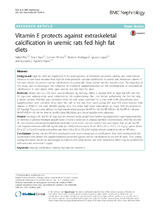| dc.contributor.author | Ríos, Rafael | |
| dc.contributor.author | Raya, Ana I. | |
| dc.contributor.author | Pineda Martos, Carmen María | |
| dc.contributor.author | Rodríguez, Mariano | |
| dc.contributor.author | López, Ignacio | |
| dc.contributor.author | Aguilera Tejero, Escolástico | |
| dc.date.accessioned | 2018-12-03T13:32:44Z | |
| dc.date.available | 2018-12-03T13:32:44Z | |
| dc.date.issued | 2017 | |
| dc.identifier.uri | http://hdl.handle.net/10396/17552 | |
| dc.description.abstract | Background:
High fat diets are implicated in the pathogenesis of metabolic syndrome, obesity and renal disease.
Previous studies have revealed that high fat diets promote vascular calcification in uremic rats. Moreover, vitamin E
has been shown to prevent uremic calcifications in genetically obese Zucker rats fed standard diet. The objective of
this study was to investigate the influence of vitamin E supplementation on the development of extraskeletal
calcifications in non-obese (wild type) uremic rats fed high fat diets.
Methods:
Wistar rats (
n
= 32) were preconditioned by feeding either a normal (NF) or high fat (HF) diet for
45 days and subsequently were subjected to 5/6 nephrectomy (Nx). Just before performing the first Nx step,
a blood sample (Pre-Nx) was obtained. After Nx rat
s were switched to a diet with 0.9% phosphorus and
supplemented with calcitriol. Also, after Nx, half of the rats from each group (NF and HF) were treated with
vitamin E (VitE) in the diet (30,000 mg/kg) and the ot
her half were maintained on basic VitE requirements
(27 mg/kg). Thus, rats were allotted to four experimental groups: Nx-NF (
n
= 8), Nx-NF-VitE (
n
=8),Nx-HF(
n
=8)and
Nx-HF-VitE (
n
= 8). At the time of sacrifice (day 66), blood and tissue samples were obtained.
Results:
Feeding a HF diet for 45 days did not increase body weight but elicited hyperglycemia, hypertriglyceridemia,
an increase in plasma fibroblast growth factor 23 and a reduction in plasma calcitriol concentrations. After Nx, rats fed
HF diet showed substantial extraskeletal calcification with aortic calcium content that was higher than in rats fed NF
diet. Supplementation with VitE significantly (
p
< 0.05) reduced aortic (from 38.4 ± 8.8 to 16.5 ± 1.4 mg/g), gastric (from
5.6 ± 2.7 to 1.2 ± 0.4 mg/g) and pulmonary (from 1.8 ± 0.3 to 0.3 ± 0.2 mg/g) calcium content in rats on HF diets.
Conclusions:
Uremic rats fed HF diets developed more severe extraosseous calcifications than their normocaloric-fed
counterparts and dietary VitE supplementation protected against uremic calcifications in rats fed HF diets. Thus, eating
energy-rich foods should be discouraged in patients with renal disease and their deleterious effect may be ameliorated
with adequate antioxidant supply | es_ES |
| dc.format.mimetype | application/pdf | es_ES |
| dc.language.iso | eng | es_ES |
| dc.publisher | Biomed Central | es_ES |
| dc.rights | https://creativecommons.org/licenses/by-nc-nd/4.0/ | es_ES |
| dc.source | BMC Nephrology 18:374 (2017) | es_ES |
| dc.subject | Vascular calcification | es_ES |
| dc.subject | Uremia | es_ES |
| dc.subject | High-fat diet | es_ES |
| dc.subject | Vitamin E | es_ES |
| dc.title | Vitamin E protects against extraskeletal calcification in uremic rats fed high fat diets | es_ES |
| dc.type | info:eu-repo/semantics/article | es_ES |
| dc.relation.publisherversion | https://doi.org/10.1186/s12882-017-0790-4 | es_ES |
| dc.relation.projectID | Gobierno de España. PI14/00467 | es_ES |
| dc.relation.projectID | Gobierno de España. PI14/00638 | es_ES |
| dc.rights.accessRights | info:eu-repo/semantics/openAccess | es_ES |

